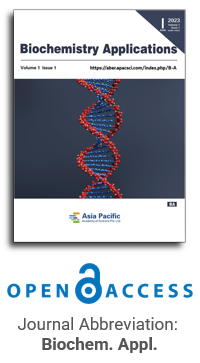
Asia Pacific Academy of Science Pte. Ltd. (APACSCI) specializes in international journal publishing. APACSCI adopts the open access publishing model and provides an important communication bridge for academic groups whose interest fields include engineering, technology, medicine, computer, mathematics, agriculture and forestry, and environment.
In recent times, plants are known to be the novel sources for obtaining pharmacologically active drugs which are produced by them in response to the stress which in turn facilitate mutualistic and antagonistic interactions of the plant with its changing environment. Keeping in view the medicinal importance and vulnerability status of Bergenia ciliata in vitro cultures combined with mutagenesis prove to be better option for improvement of this plant. The reddish green callus obtained on Gamborg’s half strength medium supplemented with TDZ (2 mg/L) and NAA (2 mg/L) were irradiated with different doses of radiations and evaluated for various parameters. The maximum carotenoid content was found in 0.5 Gy treated callus while as maximum carbohydrates were present in 1.0 Gy treated callus (7.36 mg/g) as compared to non-irradiated callus (6.30 mg/g). The higher doses of gamma radiations (4.0 to 5.0 Gy) showed enhanced carbohydrate levels as compared to non-irradiated callus. The highest protein content was found in 3.0 Gy treated callus (41.1 mg/g) followed by 2.5 Gy treated callus (39.9 mg/g). The methanolic extracts of non-irradiated and irradiated callus were subjected to DPPH radical scavenging activity with maximum activity in 1.0 Gy treated sample (29.44%) followed by 1.5 Gy (23.86%). In the present study, the antioxidant enzyme activities were also evaluated (glutathione reductase, superoxide dismutase and ascorbate peroxidase) with the highest activity in 2.0 Gy treated callus as compared to non-irradiated callus. The dried callus was examined for quantification of alkaloids and tannins. Both alkaloids and tannins were significantly higher in 1.5 Gy treated callus. Gamma irradiations showed overall increase in the phenol content with highest concentration in 0.5 Gy treated callus (0.35 mg/mL). With regard to flavonoids, lower doses of gamma irradiation showed inhibitory effect on the flavonoid synthesis in the present study. The highest flavonoid content was found in 4.5 Gy (0.26 mg/mL) as compared to control (0.08 mg/mL). The maximum arbutin was found in 3.0 Gy treated sample (366.27 µg/g) while as maximum bergenin was found in non-irradiated samples (2.47 µg/g) which was analysed via HPLC.
Most studies on menopause have focused on disorders related to sex hormone deficiency in older women. Few studies have focused on the relationship between the occurrence of diseases and the age of menopause. There is evidence that reports a higher rate of disease in women with early or late menopause.
Rapid advancements not only facilitate human adaptation but also trigger environmental adjustments. While pivotal discoveries like Penicillin revolutionized medicine, the subsequent overuse of antibiotics led to diminishing efficacy due to antibiotic resistance. Addressing biofilm formation as a major contributor to antimicrobial resistance and recognizing quorum sensing as a key factor in biofilm formation, there is a need for new strategies. Glutathione, a natural antioxidant, has shown promising potential as an effective antimicrobial agent and a reliable component for cellular defence in the immune system. This study explores the capability of Glutathione to mitigate quorum sensing-induced biofilm formation in Klebsiella pneumoniae and Serratia marcescens. The results demonstrated that glutathione induced ROS-mediated cell death in these bacteria. Glutathione exhibited a maximum inhibition of approximately 85% in biofilm formation for both K. pneumoniae and S. marcescens. It also effectively disrupted preformed biofilms by degrading the eDNA of the EPS layer of matured biofilms. Interestingly, glutathione attenuated the quorum sensing pathway, as evidenced by reduced production of virulence factors, thereby mitigating QS-induced biofilm formation in both bacteria. This work lays the groundwork for further exploration in developing glutathione as a novel antibiotic to combat antibiotic resistance.
SARS-CoV-2 is highly transmissible and pathogenic, with nearly 6.5 million infected people dying worldwide. A severe acute respiratory syndrome is one of the primary COVID-19 outcomes, often related to bacterial co-infections. In addition, infective variants of SARS-CoV-2 have constantly emerged in different countries, causing recurrent waves of infection. These variants increase the chances of vaccine failure, even in countries with accelerated vaccination programs, such as Israel and the USA. In this brief review, the subjects addressed include aspects of the SARS-CoV-2 variants, vaccines, drug therapy, and new alternative therapies. Finally, this review also discussed articles that addressed the repositioning of drugs against the SarsCov2 MPro enzyme using in silico approaches. In addition, we discussed the repositioning of drugs in silico, which can be a valuable strategy to guide and optimize the selection of elective compounds already approved for human use. Bearing in mind that few drugs, such as nirmatrelvir, ritonavir (Paxlovid), molnupiravir, and some monoclonal antibodies, have received authorization throughout the COVID-19 pandemic, according to Food and Drug Administration guidelines.

Prof. Stephane Petoud
Center for Molecular Biophysics, France

Octavio Paredes-Lopez
CINVESTAV-IPN IRAPUATO, Mexico


 Open Access
Open Access